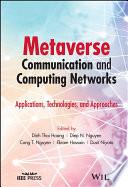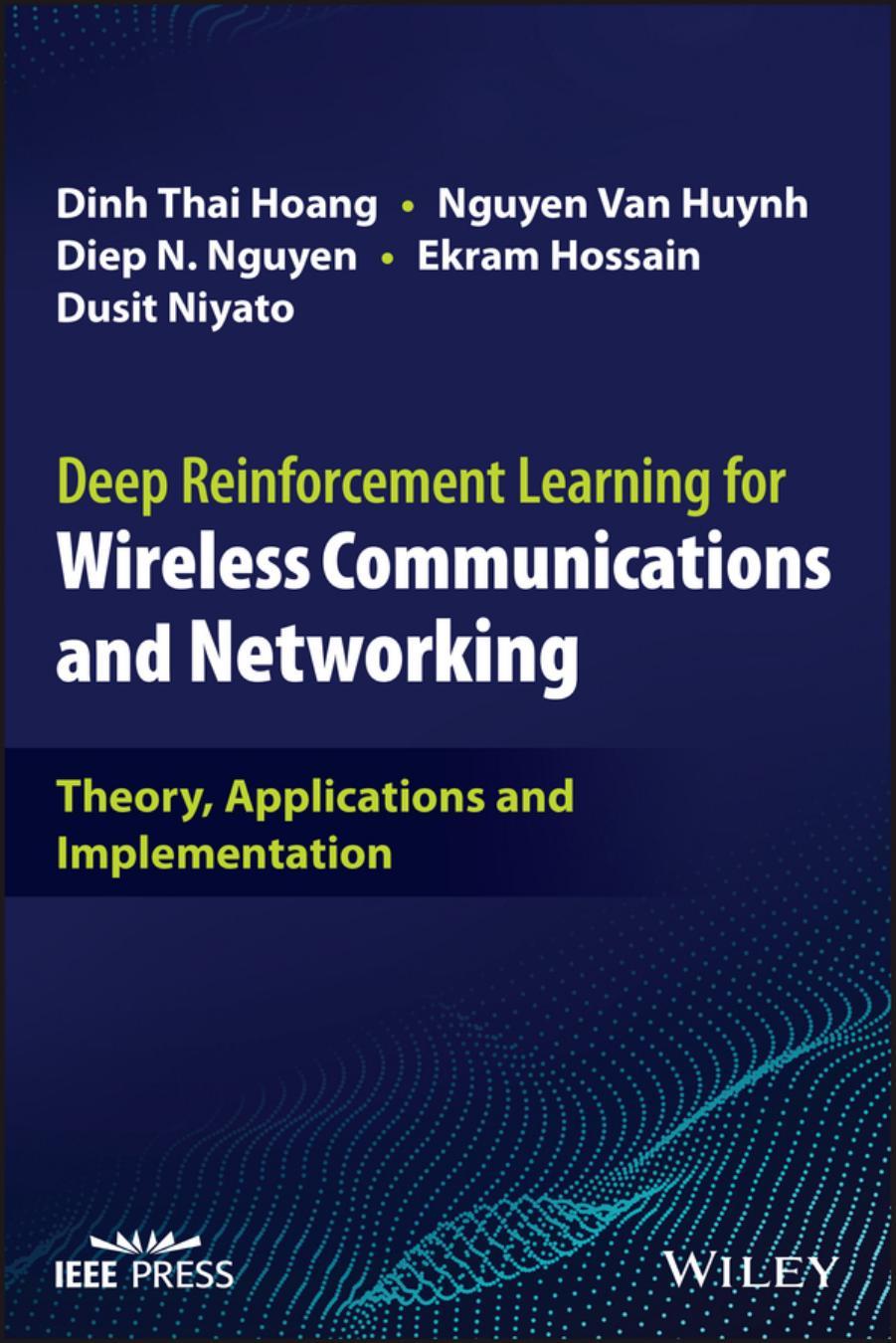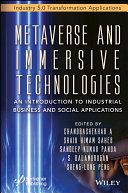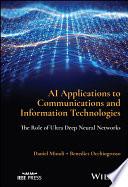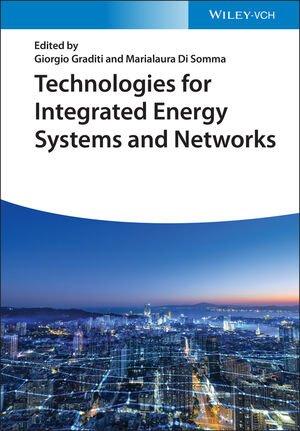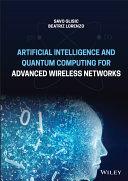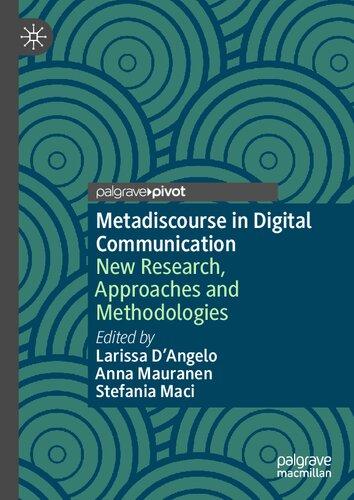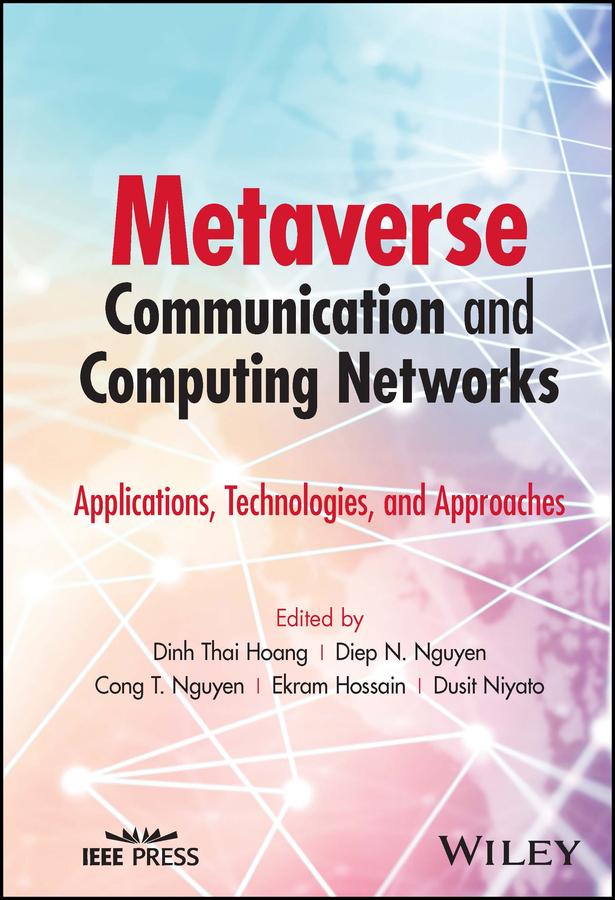MetaverseCommunication andComputingNetworks
Applications,Technologies,andApproaches
Editedby
DinhThaiHoang
UniversityofTechnologySydney,Australia
DiepN.Nguyen
UniversityofTechnologySydney,Australia
CongT.Nguyen
DuyTanUniversity,Vietnam
EkramHossain UniversityofManitoba,Canada
DusitNiyato
NanyangTechnologicalUniversity,Singapore
Copyright©2024byTheInstituteofElectricalandElectronicsEngineers,Inc. Allrightsreserved.
PublishedbyJohnWiley&Sons,Inc.,Hoboken,NewJersey. PublishedsimultaneouslyinCanada.
Nopartofthispublicationmaybereproduced,storedinaretrievalsystem,ortransmittedinany formorbyanymeans,electronic,mechanical,photocopying,recording,scanning,orotherwise, exceptaspermittedunderSection107or108ofthe1976UnitedStatesCopyrightAct,without eitherthepriorwrittenpermissionofthePublisher,orauthorizationthroughpaymentofthe appropriateper-copyfeetotheCopyrightClearanceCenter,Inc.,222RosewoodDrive,Danvers, MA01923,(978)750-8400,fax(978)750-4470,oronthewebatwww.copyright.com.Requeststo thePublisherforpermissionshouldbeaddressedtothePermissionsDepartment,JohnWiley& Sons,Inc.,111RiverStreet,Hoboken,NJ07030,(201)748-6011,fax(201)748-6008,oronlineat http://www.wiley.com/go/permission.
Trademarks:WileyandtheWileylogoaretrademarksorregisteredtrademarksofJohnWiley& Sons,Inc.and/oritsaffiliatesintheUnitedStatesandothercountriesandmaynotbeused withoutwrittenpermission.Allothertrademarksarethepropertyoftheirrespectiveowners. JohnWiley&Sons,Inc.isnotassociatedwithanyproductorvendormentionedinthisbook.
LimitofLiability/DisclaimerofWarranty
Whilethepublisherandauthorhaveusedtheirbesteffortsinpreparingthisbook,theymakeno representationsorwarrantieswithrespecttotheaccuracyorcompletenessofthecontentsof thisbookandspecificallydisclaimanyimpliedwarrantiesofmerchantabilityorfitnessfora particularpurpose.Nowarrantymaybecreatedorextendedbysalesrepresentativesorwritten salesmaterials.Theadviceandstrategiescontainedhereinmaynotbesuitableforyour situation.Youshouldconsultwithaprofessionalwhereappropriate.Further,readersshouldbe awarethatwebsiteslistedinthisworkmayhavechangedordisappearedbetweenwhenthis workwaswrittenandwhenitisread.Neitherthepublishernorauthorsshallbeliableforany lossofprofitoranyothercommercialdamages,includingbutnotlimitedtospecial,incidental, consequential,orotherdamages.
Forgeneralinformationonourotherproductsandservicesorfortechnicalsupport,please contactourCustomerCareDepartmentwithintheUnitedStatesat(800)762-2974,outsidethe UnitedStatesat(317)572-3993orfax(317)572-4002.
Wileyalsopublishesitsbooksinavarietyofelectronicformats.Somecontentthatappearsin printmaynotbeavailableinelectronicformats.FormoreinformationaboutWileyproducts, visitourwebsiteatwww.wiley.com.
LibraryofCongressCataloging-in-PublicationDataappliedfor:
HardbackISBN:9781394159987
CoverDesign:Wiley
CoverImage:©OlgaSiletskaya/GettyImages
Setin9.5/12.5ptSTIXTwoTextbyStraive,Chennai,India
Tomyfamily
—DinhThaiHoang
Tomyfamily
—DiepN.Nguyen
Tomyfamily
—CongT.Nguyen
Tomyparents
—EkramHossain
Tomyfamily
—DusitNiyato
Contents
Editors’Biography xvi
ListofContributors xix
Preface xxiv
Acknowledgments xxv
Introduction xxvi
1Metaverse:AnIntroduction 1
Lik-HangLee,DimitrisChatzopoulos,PengyuanZhou,andTristanBraud
1.1Introduction 1
1.2TheMetaverse:Fantasy,Text,3DWorlds 3
1.3TheRiseofEdgeComputing 4
1.3.1Offloading 4
1.3.2ScaletoOutdoor 5
1.4Universality,Interoperability,andOpenness 6
1.4.1UsingtheWorldWideWebasanIllustration 6
1.4.2RealizingthePotentialofInteroperabilityintheMetaverse 7
1.4.3TheArgumentinFavorofImmersiveTechnologies 8
1.5StepsTowardMobileUserInteractionWithintheMetaverse 9
1.6BringingUsers’ProfilesandAssetsontheMetaverse 10
1.6.1TheRoleofDistributedLedgers,SmartContracts,andDecentralized Storage 11
1.7ConclusionsandFutureResearchDirections 12 Bibliography 13
2PotentialApplicationsandBenefitsofMetaverse 17
MshariAljumaie,HieuChiNguyen,NamH.Chu,CongT.Nguyen, DiepN.Nguyen,DinhThaiHoang,andErykDutkiewicz
2.1MetaverseApplicationsforEntertainment 17
2.1.1IntroductiontoEntertainment 17
2.1.2ExistingEntertainmentActivities 18
2.1.3EntertainmentActivitiesinMetaverse 20
2.1.4ChallengesofEntertainmentintheMetaverse 22
2.2VirtualOfficeinMetaverse 22
2.2.1IntroductiontoVirtualOffice 22
2.2.2CurrentVirtualOfficePlatformsTowardMetaverse 23
2.2.3BenefitsandPotentialUseCasesofMetaverseWorkplace 25
2.2.4ChallengesofVirtualOfficeinMetaverse 26
2.3Education 27
2.3.1TheDevelopmentofOnlineLearning 27
2.3.2CurrentOnlineLearningPlatformsandChallenges 28
2.3.3EducationinMetaverse 29
2.3.4ChallengesofEducationinMetaverse 30
2.4MetaverseforHealthcareServices 31
2.5MetaverseforAutonomousVehicles 32
2.6MetaverseforVirtualTravelling 33
2.7ConclusionsandFutureResearchDirections 34 Bibliography 34
3MetaversePrototype:ACaseStudy 39 HaihanDuanandWeiCai
3.1Overview 39
3.1.1RelatedWork 39
3.1.2MotivationandImplementation 40
3.2NewbieatCUHKSZ 42
3.2.1Gameplayin NewbieatCUHKSZ43
3.2.1.1UniversityCampusExploration 43
3.2.1.2SchoolandMajorSelection 44
3.2.1.3TheSenseofSocialGood 45
3.2.2LimitationsandIteration 46
3.3CUHKSZMetaverse 47
3.3.1Three-LayerSystemDesign 47
3.3.2CampusMetaversePrototype 49
3.3.2.1InfrastructureLayer 49
3.3.2.2InteractionLayer 50
3.3.2.3EcosystemLayer 55
3.4ConclusionsandFutureResearchDirections 59 Acknowledgement 60 Bibliography 61
4WirelessTechnologiesfortheMetaverse 63
HongliangZhang,ShiwenMao,andZhuHan
4.1Introduction 63
4.2XRoverNR:Standardizationin3GPP 64
4.2.1SelectedXRApplications 65
4.2.2TrafficModels 65
4.2.3MajorXR-Specific3GPPKPIs 66
4.2.3.1Capacity 66
4.2.3.2PowerConsumption 66
4.3CaseStudy:Location-DependentARServicesintheWireless Edge-EnabledMetaverse 67
4.3.1SystemModel 67
4.3.1.1UplinkPhase 69
4.3.1.2DownlinkPhase 70
4.3.2ProblemFormulation 72
4.3.2.1ImpactofEstimationError 73
4.3.2.2QoEModel 74
4.3.2.3ProblemStatement 74
4.3.3AlgorithmDesign 75
4.3.3.1WaveformDesignAlgorithmfortheUplinkSubproblem 75
4.3.3.2JointResolutionandTransmitPowerOptimizationAlgorithmforthe DownlinkSubproblem 76
4.3.4SimulationResults 77
4.3.4.1Settings 77
4.3.4.2EvaluationResults 79
4.4ConclusionsandFutureResearchDirections 81 Acknowledgment 82 Bibliography 82
5AIandComputerVisionTechnologiesforMetaverse 85
Thien-HuynhThe,Quoc-VietPham,Xuan-QuiPham,TanDo-Duy, andThippaReddyGadekallu
5.1Introduction 85
5.1.1MainContributions 86
5.1.2ChapterOrganization 87
5.2AIfortheMetaverse 87
5.2.1PreliminaryofAI 87
5.2.1.1ConventionalTechniques 87
5.2.1.2AdvancedTechniques 89
5.2.2RolesofAIintheMetaverse 90
5.2.2.1DataProcessing 91
5.2.2.2DataManagement 92
5.2.2.3ResourceManagement 93
5.2.2.4Modeling 95
5.2.2.5NeuralInterface 96
5.2.3AIforMetaverseApplications 97
5.2.3.1Healthcare 97
5.2.3.2Manufacturing 98
5.2.3.3SmartCities 99
5.2.3.4Gaming 100
5.2.3.5Others 101
5.3ComputerVisionfortheMetaverse 101
5.3.1FundamentalComputerVisionTasks 103
5.3.1.1ImageClassification 103
5.3.1.2ObjectDetection 104
5.3.1.3ImageSegmentation 105
5.3.1.4HumanPoseEstimation 107
5.3.1.5Others 109
5.3.2ComputerVisionforMetaverseApplications 110
5.3.2.1AutonomousDriving 110
5.3.2.2Healthcare 111
5.3.2.3Manufacturing 113
5.3.2.4Others 114
5.4ConclusionsandFutureResearchDirections 115 Bibliography 117
6Virtual/Augmented/MixedRealityTechnologies forEnablingMetaverse 125 HoweYuanZhuandChin-TengLin
6.1Introduction 125
6.1.1IntotheMetaverse:HumanConsciousnessinaVirtualWorld 125
6.1.2VR/AR/MRChallenges 127
6.2VirtualReality 129
6.2.1TechnologyOverview 129
6.2.2UserImmersion 130
6.2.3MetaverseContinuity 132
6.2.4UserInteraction 133
6.2.5Summary 135
6.3AugmentedReality 135
x Contents
6.3.1TechnologyOverview 135
6.3.2UserImmersion 136
6.3.3MetaverseContinuity 137
6.3.4UserInteraction 138
6.3.5Summary 139
6.4MixedReality 139
6.4.1TechnologyOverview 139
6.4.2UserImmersion 140
6.4.3MetaverseContinuity 141
6.4.4UserInteraction 141
6.4.5Summary 143
6.5ConclusionsandFutureResearchDirections 143 Acknowledgments 144 Bibliography 145
7BlockchainfortheMetaverse:State-of-the-Art andApplications 157 PawanKumarHegde,RajeswariChengoden,NancyVictor, ThienHuynhThe,SwetaBhattacharya,PraveenKumarReddy Maddikunta,ThippaReddyGadekallu,andQuoc-VietPham
7.1Introduction 157
7.2Background 161
7.2.1Blockchain 161
7.2.2Blockchain-BasedSolutionsfortheMetaverse 164
7.3UseCasesofBlockchainfortheMetaverse 167
7.3.1Privacy 168
7.3.2Security 169
7.3.3Traceability 170
7.3.4Decentralization 170
7.3.5Ownership 171
7.3.6Governance 172
7.3.7TrustandAccountability 173
7.4Projects 174
7.4.1AxieInfinity 174
7.4.2DecentralandMANA 174
7.4.3TheSandbox(SAND) 175
7.4.4Enjin(ENJ) 176
7.5ConclusionsandFutureResearchDirections 176 Bibliography 177
8EdgeComputingTechnologiesforMetaverse 183 MinruiXuandDusitNiyato
8.1AnOverviewofEdge-enabledMetaverse 184
8.1.1CommunicationandNetworking 185
8.1.1.1Rate-Reliability-Latency3DMultimediaNetworks 186
8.1.1.2Human-in-the-loopCommunication 187
8.1.1.3Real-timePhysical-VirtualSynchronization 187
8.1.2ComputationattheEdge 188
8.1.2.1EfficientAR/VRCloud-Edge-EndRendering 189
8.1.2.2ScalableAIModelTraining 190
8.1.2.3ComputationalPrivacyandSecurity 190
8.2OpportunitiesandChallengesintheEdge-enabledMetaverse 191
8.2.1OpportunitiesandChallengesinEdgeCommunication 191
8.2.2OpportunitiesandChallengesinEdgeComputing 192
8.3Edge-EnabledMetaverse:ReleasetheUbiquitousComputingand IntelligenceattheEdge 194
8.3.1VRRemoteRenderingviaEdgeComputingTechnologies 194
8.3.1.1Background 194
8.3.1.2Motivation 194
8.3.1.3Contribution 195
8.3.2Edge-EnabledPhysical–VirtualSynchronization 196
8.3.2.1Background 196
8.3.2.2Motivation 197
8.3.2.3Contribution 198
8.4ConclusionsandFutureResearchDirections 199 Bibliography 200
9SecurityIssuesinMetaverse 205 YuntaoWang,ZhouSu,NingZhang,DongxiaoLiu,RuiXing,TomH.Luan, andXueminShen
9.1OverviewofSecurityandPrivacyThreatsinMetaverse 205
9.2ThreatsandCountermeasurestoAuthenticationandAccessControlin Metaverse 207
9.2.1ThreatstoAuthenticationinMetaverse 207
9.2.2ThreatstoAccessControlinMetaverse 208
9.2.3SecurityCountermeasurestoMetaverseAuthenticationandAccess Control 209
9.2.3.1KeyManagementforWearableDevices 210
9.2.3.2IdentityAuthenticationforWearableDevices 210
9.2.3.3Cross-DomainIdentityAuthentication 211
9.2.3.4Fine-GrainedAccessControlandUsageAuditforWearablesand UGCs 211
9.3ThreatsandCountermeasurestoDataManagementinMetaverse 212
9.3.1ThreatstoDataManagementinMetaverse 212
9.3.2SecurityCountermeasurestoMetaverseDataManagement 213
9.3.2.1DataReliabilityofAIGC,DigitalTwin,andPhysicalInput 214
9.3.2.2DataQualityofUGCandPhysicalInput 215
9.3.2.3SecureDataSharinginXREnvironment 215
9.3.2.4ProvenanceofUGC 216
9.4PrivacyThreatsandCountermeasuresinMetaverse 216
9.4.1PrivacyThreatsinMetaverse 216
9.4.2PrivacyCountermeasuresinMetaverse 219
9.4.2.1PrivacyinMetaverseGames 219
9.4.2.2Privacy-PreservingUGCSharingandProcessing 219
9.4.2.3ConfidentialityProtectionofUGCandPhysicalInput 220
9.4.2.4DigitalFootprintsProtection 220
9.4.2.5PersonalizedPrivacy-PreservingMetaverse 220
9.4.2.6Privacy-EnhancingAdvancesinIndustry 221
9.5Network-RelatedThreatsandCountermeasuresinMetaverse 222
9.5.1ThreatstoMetaverseNetwork 222
9.5.2SituationalAwarenessinMetaverse 222
9.5.2.1LocalSituationalAwareness 223
9.5.2.2GlobalSituationalAwareness 224
9.6Economy-RelatedThreatsandCountermeasuresinMetaverse 225
9.6.1ThreatstoMetaverseEconomy 225
9.6.2OpenandDecentralizedCreatorEconomy 226
9.6.2.1TrustedUGC/Asset/ResourceTrading 226
9.6.2.2EconomicFairnessforManipulationPrevention 227
9.6.2.3OwnershipTraceabilityofDigitalAssets 227
9.7ThreatstoPhysicalWorldandHumanSocietyandCountermeasures inMetaverse 228
9.7.1ThreatstoPhysicalWorldandHumanSociety 228
9.7.2PhysicalSafety 229
9.7.2.1CyberInsurance-BasedSolutions 229
9.7.2.2CPSS-BasedSolutions 229
9.7.3SocietyManagement 229
9.7.3.1MisinformationSpreadingMitigation 229
9.7.3.2HumanSafetyandCyberSyndromes 230
9.8Governance-RelatedThreatsandCountermeasuresinMetaverse 230
9.8.1ThreatstoMetaverseGovernance 230
9.8.2DigitalGovernanceinMetaverse 231
9.8.2.1AIGovernance 231
9.8.2.2DecentralizedGovernance 232
9.9ConclusionsandFutureResearchDirections 232 Bibliography 233
10IoT-AssistedMetaverseServices 241 YueHan,CyrilLeung,andDongInKim
10.1WhyNeedIoTforMetaverseServices 241
10.1.1MetaverseandVirtualServices 241
10.1.1.1AugmentinganIndividual’sExperience 242
10.1.1.2AugmentingIndustryServicesorOperations 242
10.1.2DigitalTwins 243
10.1.2.1DefinitionofDTs 244
10.1.2.2DifferenceBetweenMetaverseandDTs 244
10.1.2.3PositionofIoTinMetaverseDTConstruction 245
10.2HowtoUseIoTforMetaverseDTs 246
10.2.1MobileCrowdsensing 246
10.2.2Scenarios 247
10.2.3ChallengesofUsingIoT-EnabledMCSforMetaverseDTs 247
10.2.3.1Incentives 248
10.2.3.2DataQuality 248
10.2.3.3ResourceManagement 248
10.2.3.4DTValuefortheVirtualBusiness 248
10.2.3.5VSPs’TolerancetoNonupdatedDTs 248
10.2.3.6DecisionSequenceAmongVSPsintheMetaverseEcosystem 249
10.3ADynamicalHierarchicalGame-TheoreticalApproachfor IoT-AssistedMetaverseSynchronization 249
10.3.1Lower-LevelEvolutionaryGame 252
10.3.2Upper-LevelDifferentialGameforVSPs 253
10.3.2.1SimultaneousDecision-MakingSetting 253
10.3.2.2Open-LoopNashSolutions 255
10.3.2.3HierarchicalDecision-MakingSetting 257
10.3.3SimulationResults 259
10.4ConclusionsandFutureResearchDirections 260 Bibliography 262
11QuantumTechnologiesfortheMetaverse:Opportunities andChallenges 267 MahdiChehimiandWalidSaad
11.1Introduction 267
11.2Preliminaries 270
11.3QuantumComputingforaFasterMetaverse 274
11.3.1QuantumComputingSpeedups 274
11.3.2QuantumComputingforLowLatency 275
11.3.3QuantumComputingforSynchronizedDTs 275
11.3.4QuantumComputingforResponsiveXR 275
11.3.5ChallengesforQuantumComputingintheMetaverse 276
11.4QuantumMachineLearningforContextualMetaverse 277
11.4.1ThePowerofQMLModels 277
11.4.2QMLforSemantics’Extraction 278
11.4.3QMLforQuantumConversationalAI 279
11.4.4QuantumFederatedLearningintheMetaverse 279
11.4.5ChallengesFacingQMLintheMetaverse 280
11.5QuantumCommunicationsforSecureMetaverse 281
11.5.1Quantum-EnhancedSecurity 281
11.5.2Quantum-SecuredXRandDTs 282
11.5.3Quantum-EnhancedThroughput 283
11.5.4QuantumCloudService 283
11.5.5ChallengesFacingQuantumCommunicationsintheMetaverse 284
11.6ConclusionsandFutureResearchDirections 285 Bibliography 286
12TheMetaversewithLifeandEverything:AnOverview ofPrivacy,Ethics,andGovernance 293 Lik-HangLee,CarlosBermejo,andPanHui
12.1Introduction 293
12.2PrivacyandSecurity 295
12.2.1ConfidentialitywithRegardtotheSenses 295
12.2.2ProtectionofOne’sActionsandConversationsinPrivate 296
12.2.3TheProtectionofParticipantsandBystanders 297
12.2.4OpenChallenges 298
12.3Governance 299
12.3.1StatutesandRegulations 299
12.3.2DistributedLedgerTechnology(DLT)andDecentralizedAutonomous Organizations(DAO) 300
12.3.3EthicalGovernanceBasedonModules 300
12.3.4TheRoleofOnlinePlatformsinContributingtotheCommon Good 301
12.3.5OpenChallenges 301
12.4Creation,SocialGood,andEthicalDesign 302
12.4.1TheBeginningofEverythingintheMetaverse 302
12.4.2TheOnlineCommunitySpace 304
12.4.3EthicalStructurewithModularDesigns 305 12.5ConclusionsandFutureResearchDirections 308 Bibliography 308
Index 311
Editors’Biography
DinhThaiHoang receivedhisPhDdegreefromtheSchoolofComputerScience andEngineering,NanyangTechnologicalUniversity,Singapore,in2016.Heis currentlyafacultymemberattheUniversityofTechnologySydney(UTS), Australia.Overthepast10years,hehassignificantlycontributedtoadvanced wirelesscommunicationsandnetworkingsystems.Thisisevidencedbyhis excellentrecordwithonepatentfiledbyAppleInc.,twoauthoredbooks,one editedbook,fourbookchapters,morethan80IEEEQ1journals,and60flagship IEEEconferencepapersintheareasofcommunicationsandnetworking.Most ofhisjournalpapershavebeenpublishedintopIEEEjournals,includingIEEE JSAC,IEEETWC,IEEECOMST,andIEEETCOM.Furthermore,hisresearch papershavehadahighimpact,asevidencedbynearly14,000citationswith anh-indexof44(accordingtoGoogleScholar)overthepast10years.Since joiningUTSin2018,hehasreceivedmorethanAUD3millioninexternal fundingandseveralpreciousawards,includingtheAustralianResearchCouncil DiscoveryEarlyCareerResearcherAwardforhisproject“IntelligentBackscatter CommunicationsforGreenandSecureIoTNetworks”andIEEETCSCAward forExcellenceinScalableComputingforContributionson“IntelligentMobile EdgeComputingSystems”(EarlyCareerResearcher).Alternatively,heisthelead authoroftwoauthoredbooks,“AmbientBackscatterCommunicationNetworks,” publishedbyCambridgePublisherin2020and“DeepReinforcementLearningfor WirelessCommunicationsandNetworking,”publishedbyIEEE-WileyPublisher in2022.HeiscurrentlyanEditorofIEEETMC,IEEETWC,IEEETCCN,IEEE TVT,andIEEECOMST.
DiepN.Nguyen isafacultymemberoftheFacultyofEngineeringand InformationTechnology,UniversityofTechnologySydney(UTS).Hereceived MEandPhDinElectricalandComputerEngineeringfromtheUniversityof CaliforniaSanDiego(UCSD)andtheUniversityofArizona(UA),respectively. BeforejoiningUTS,hewasaDECRAResearchFellowatMacquarieUniversity,
amemberoftechnicalstaffatBroadcom(California),ARCONCorporation (Boston),consultingtheFederalAdministrationofAviationonturningdetection ofUAVsandaircraft,USAirForceResearchLabonanti-jamming.Hehasreceived severalawardsfromLGElectronics,theUniversityofCaliforniaSanDiego,the UniversityofArizona,USNationalScienceFoundation,andAustralianResearch Council,includingnominationsfortheoutstandingRA(2013)awards,thebest paperawardattheWiOptconference(2014),DiscoveryEarlyCareerResearcher Award(DECRA,2015),andoutstandingEarlyCareerResearcheraward(SEDE, UniversityofTechnologySydney,2018).Hisrecentresearchinterestsareinthe areasofcomputernetworking,wirelesscommunications,andmachinelearning application,withanemphasisonsystems’performanceandsecurity/privacy.
Dr.NguyenisaseniormemberofIEEEandaneditor/associateeditorofthe IEEE TransactionsonMobileComputing, IEEEAccess,Sensors journal,and IEEEOpen JournaloftheCommunicationsSociety (OJ-COMS).
CongT.Nguyen receivedhisBEdegreeinElectricalEngineeringandInformationTechnologyfromFrankfurtUniversityofAppliedSciencesin2014,hisMSc inGlobalProductionEngineeringandManagementfromtheTechnicalUniversityBerlinin2016,andhisPhDinInformationTechnologyfromUniversityof TechnologySydneyin2023.HeiscurrentlywithDuyTanUniversity,Vietnam. Hisresearchinterestsincludeblockchaintechnology,operationresearch,game theory,andoptimization.
EkramHossain isaprofessorandanassociatehead(GraduateStudies)atthe DepartmentofElectricalandComputerEngineering,UniversityofManitoba, Canada.Heisamember(Classof2016)oftheCollegeoftheRoyalSocietyof Canada.Hiscurrentresearchinterestsincludedesign,analysis,andoptimization of6Gcellularwirelessnetworks.HewaslistedasaClarivateAnalyticsHighly CitedResearcherinComputerScienceforsixyearsinarowfrom2017to2022.He receivedthe2017IEEEComSocTechnicalCommitteeonGreenCommunications andComputingDistinguishedTechnicalAchievementRecognitionAward“for outstandingtechnicalleadershipandachievementingreenwirelesscommunicationsandnetworking.”Hehaswonseveralresearchawards,includingthe 2017IEEECommunicationsSocietyBestSurveyPaperAwardandthe2011IEEE CommunicationsSocietyFredEllersickPrizePaperAward.Heservedasthe editor-in-chieffortheIEEECommunicationsSurveysandTutorialsfrom2012to 2016andtheeditor-in-chiefforIEEEPress.Hewasadistinguishedlecturerofthe IEEECommunicationsSocietyandtheIEEEVehicularTechnologySociety.He wasanelectedmemberoftheboardofgovernorsoftheIEEECommunications Societyforthetermfrom2018to2020.HewaselevatedtoanIEEEfellow“for contributionstospectrummanagementandresourceallocationincognitiveand
cellularradionetworks.”HeisafellowoftheCanadianAcademyofEngineering andafellowoftheEngineeringInstituteofCanada.
DusitNiyato isaprofessorattheSchoolofComputerScienceandEngineering,NanyangTechnologicalUniversity,Singapore.HereceivedBEfromKing Mongkuk’sInstituteofTechnologyLadkrabang(KMITL),Thailand,in1999and aPhDinElectricalandComputerEngineeringfromtheUniversityofManitoba, Canada,in2008.Dusit’sresearchinterestsareintheareasofdistributedcollaborativemachinelearning,theInternetofThings(IoT),edgeintelligentmetaverse, mobileanddistributedcomputing,andwirelessnetworks.DusitwontheBest YoungResearcherAwardofIEEECommunicationsSociety(ComSoc)AsiaPacific andthe2011IEEECommunicationsSocietyFredW.EllersickPrizePaperAward andtheIEEEComputerSocietyMiddleCareerResearcherAwardforExcellence inScalableComputingin2021andDistinguishedTechnicalAchievementRecognitionAwardofIEEEComSocTechnicalCommitteeonGreenCommunications andComputing2022.Dusitalsowonanumberofbestpaperawards,including IEEEWirelessCommunicationsandNetworkingConference(WCNC),IEEE InternationalConferenceonCommunications(ICC),IEEEComSocCommunicationSystemsIntegrationandModellingTechnicalCommittee,andIEEEComSoc SignalProcessingandComputingforCommunicationsTechnicalCommittee 2021.Currently,Dusitisservingaseditor-in-chiefofIEEECommunicationsSurveysandTutorials,anareaeditorofIEEETransactionsonVehicularTechnology, editorofIEEETransactionsonWirelessCommunications,associateeditorof IEEEInternetofThingsJournal,IEEETransactionsonMobileComputing,IEEE WirelessCommunications,IEEENetwork,andACMComputingSurveys.He wasaguesteditoroftheIEEEJournalonSelectedAreasonCommunications.He wasadistinguishedlectureroftheIEEECommunicationsSocietyfor2016–2017. Hewasnamedthe2017–2021highlycitedresearcherincomputerscience.Heis afellowofIEEEandafellowofIET.
ListofContributors
MshariAljumaie SchoolofElectricalandData Engineering UniversityofTechnologySydney
Ultimo,NSW
Australia and DepartmentofInformation Technology
TaifUniversity
Taif SaudiArabia
CarlosBermejo DepartmentofComputerScienceand Engineering,SchoolofEngineering
TheHongKongUniversityofScience andTechnology
HongKongSAR
China
SwetaBhattacharya SchoolofInformationTechnologyand Engineering
VelloreInstituteofTechnology
TamilNadu
India
TristanBraud DivisionofIntegrativeSystemsand Design
HongKongUniversityofScienceand Technology HongKongSAR
China
WeiCai SchoolofScienceandEngineering TheChineseUniversityofHongKong Shenzhen,Shenzhen
China
DimitrisChatzopoulos SchoolofComputerScience UniversityCollegeDublin Dublin
Ireland MahdiChehimi Wireless@VT BradleyDepartmentofElectricaland ComputerEngineering,VirginiaTech Arlington,VA USA
xx ListofContributors
RajeswariChengoden
SchoolofInformationTechnologyand Engineering
VelloreInstituteofTechnology
TamilNadu
India
HieuChiNguyen
SchoolofElectricalandData Engineering
UniversityofTechnologySydney Ultimo,NSW
Australia
NamH.Chu
SchoolofElectricalandData Engineering
UniversityofTechnologySydney Ultimo,NSW
Australia
TanDo-Duy DepartmentofComputerand CommunicationEngineering
HoChiMinhCityUniversityof TechnologyandEducation
HoChiMinhCity
Vietnam
HaihanDuan SchoolofScienceandEngineering
TheChineseUniversityofHongKong Shenzhen,Shenzhen
China
ErykDutkiewicz
SchoolofElectricalandData Engineering
UniversityofTechnologySydney Ultimo,NSW
Australia
ThippaReddyGadekallu SchoolofInformationTechnologyand Engineering
VelloreInstituteofTechnology
TamilNadu
India and
DepartmentofElectricaland ComputerEngineering
LebaneseAmericanUniversity
Byblos
Lebanon
ZhuHan DepartmentofElectricaland ComputerEngineering UniversityofHouston
Houston,TX
USA
YueHan
Alibaba-NTUSingaporeJoint ResearchInstitute
NanyangTechnologicalUniversity
Singapore
PawanKumarHegde SchoolofInformationTechnologyand Engineering
VelloreInstituteofTechnology
TamilNadu
India
DinhThaiHoang SchoolofElectricalandData Engineering
UniversityofTechnologySydney Ultimo,NSW
Australia
PanHui DepartmentofComputerScienceand Engineering,SchoolofEngineering
TheHongKongUniversityofScience andTechnology
HongKongSAR China
DongInKim DepartmentofElectricaland ComputerEngineering
SungkyunkwanUniversity Suwon,Gyeonggi-do
Korea
CyrilLeung DepartmentofElectricaland ComputerEngineering UniversityofBritishColumbia Vancouver,BC
Canada
Lik-HangLee
DepartmentofIndustrialandSystems Engineering(ISE)
TheHongKongPolytechnicUniversity HongKongSAR
China
Chin-TengLin ComputationalIntelligenceand Brain-ComputerInterface, AustralianArtificialIntelligence Institute
UniversityofTechnologySydney Ultimo,NSW
Australia
DongxiaoLiu DepartmentofElectricaland ComputerEngineering UniversityofWaterloo Waterloo,ON
Canada
TomH.Luan SchoolofCyberScienceand Engineering
Xi’anJiaotongUniversity
Xi’an,Shaanxi
China
PraveenKumarReddyMaddikunta SchoolofInformationTechnologyand Engineering
VelloreInstituteofTechnology TamilNadu
India
ShiwenMao DepartmentofElectricaland ComputerEngineering
AuburnUniversity Auburn,AL
USA
DusitNiyato SchoolofComputerScienceand Engineering
NanyangTechnologicalUniversity
Singapore
CongT.Nguyen SchoolofElectricalandData Engineering UniversityofTechnologySydney Ultimo,NSW
Australia
xxii ListofContributors
DiepN.Nguyen
SchoolofElectricalandData
Engineering
UniversityofTechnologySydney Ultimo,NSW
Australia
Quoc-VietPham SchoolofComputerScienceand Statistics
TrinityCollegeDublin
Dublin Ireland
Xuan-QuiPham
ICTConvergenceResearchCenter
KumohNationalInstituteof Technology
Gumi
Korea
WalidSaad Wireless@VT
BradleyDepartmentofElectricaland ComputerEngineering,VirginiaTech Arlington,VA
USA
XueminShen DepartmentofElectricaland ComputerEngineering UniversityofWaterloo Waterloo,ON Canada
ZhouSu SchoolofCyberScienceand Engineering
Xi’anJiaotongUniversity
Xi’an,Shaanxi
China
Thien-HuynhThe DepartmentofComputerand CommunicationEngineering
HoChiMinhCityUniversityof TechnologyandEducation
HoChiMinhCity
Vietnam
NancyVictor
SchoolofInformationTechnologyand Engineering
VelloreInstituteofTechnology
TamilNadu
India
YuntaoWang
SchoolofCyberScienceand Engineering
Xi’anJiaotongUniversity
Xi’an,Shaanxi
China
RuiXing SchoolofCyberScienceand Engineering
Xi’anJiaotongUniversity
Xi’an,Shaanxi
China
MinruiXu SchoolofComputerScienceand Engineering
NanyangTechnologicalUniversity
Singapore
HongliangZhang SchoolofElectronics PekingUniversity
Beijing China
NingZhang
DepartmentofElectricaland ComputerEngineering UniversityofWindsor
Windsor,ON
Canada
PengyuanZhou
SchoolofCyberScienceand Technology
UniversityofScienceandTechnology ofChina
Hefei China
HoweYuanZhu ComputationalIntelligenceand Brain-ComputerInterface
AustralianArtificialIntelligence Institute
UniversityofTechnologySydney Ultimo,NSW
Australia
Preface
Recently,Metaversehasgainedparamountinterestandhugeinvestmentfrom thetechindustry.MicrosoftacquiredActivisionBlizzardfor$70billionin2022 tosetitsfirstfootstepsintheMetaversegamedevelopmentrace.Alongwithits hugeinvestmentinAR,oneofthecoretechnologiesofMetaverse,Googlehas invested$39.5millioninaprivateequityfundforallMetaverseprojects.Nvidia hascreatedOmniverse,adevelopingtoolforMetaverseapplications.Besideshuge investmentsfrombigtechcompanies,theeconomicactivitiesofvirtualworldsare alsosignificant,withtransactionsthatexceedthemagnitudeofmillionsofdollars.Asaresult,thereisnodoubtthattheMetaversewillbecomeoneofthemost prominentdirectionsofdevelopmentinbothindustryandacademia.However, thedevelopmentoftheMetaverse,especiallyinacademia,isstillinanascentstage. Currently,researchersarestrivingtojudgetheshapeandboundaryofthefuture Metaverse.Theyareonlyabletoenvisionsomeofitspossiblecharacteristics,such asopenspace,decentralization,human–computerinteractionexperience,digital assets,anddigitaleconomy.Moreover,Metaverseapplicationsareexpectedtoface variouschallengessuchasmassiveresourcedemands,ultralowlatencyrequirements,interoperabilityamongapplications,andsecurityandprivacyconcerns. Giventheabove,thisbookaimstoprovideacomprehensiveoverviewofMetaverse anddiscussitsenablingtechnologiesandhowthesetechnologiescanbeutilized todevelopMetaverseapplications.
Sydney,Australia
DinhThaiHoang
DiepN.Nguyen
CongT.Nguyen EkramHossain DusitNiyato
Acknowledgments
ThecontributionmadebyDr.DinhThaiHoangwassupportedinpartby theAustralianResearchCouncil’sDiscoveryProjectsfundingscheme(project DE210100651).
ThecontributiondonebyProf.DusitNiyatowassupportedinpartbythe NationalResearchFoundation(NRF),Singapore,andInfocommMediaDevelopmentAuthorityundertheFutureCommunicationsResearchDevelopment Programme(FCP);DSONationalLaboratoriesundertheAISingaporeProgramme(AISGAwardNo:AISG2-RP-2020-019);andunderDesCartesand theCampusforResearchExcellenceandTechnologicalEnterprise(CREATE) programme.
Introduction
Editedby: DinhThaiHoang,DiepN.Nguyen,CongT.Nguyen,EkramHossain, andDusitNiyato
Theterm“Metaverse”referstonext-generationInternetapplicationsthataim tocreatevirtual3Denvironmentswherehumanscaninteractwitheachotherand theapplications’functionalitiesviadigitalavatars.Althoughtheoriginalconcept datesbackto1992,Metaversehasrecentlyattractedparamountattentiondueto thehugepotentialtorival,orevenreplace,conventionalInternetapplicationsin thenearfuture.
However,thedevelopmentoftheMetaverse,especiallyinacademia,isstillina nascentstage.Currently,researchersarestrivingtojudgetheshapeandboundary ofthefutureMetaverse.Theycanonlyenvisionsomeofitspossiblecharacteristics, suchasopenspace,decentralization,human–computerinteractionexperience, digitalassets,anddigitaleconomy.Moreover,Metaverseapplicationsareexpected tofacevariouschallenges,suchasmassiveresourcedemands,ultralowlatency requirements,applicationinteroperability,andsecurityandprivacyconcerns.
Giventheabove,thisbookaimsfirsttointroducetheemergingparadigmof Metaverse,whichisexpectedtopavethewayfortheevolutionofthefuture Internet.Thebookalsoprovidesacomprehensivereviewofthestate-of-the-art researchanddevelopmentcoveringdifferentaspectsofMetaverseforawide rangeofreaders,fromgeneralreaderstoexperts.Advancedknowledgeincluding innovativemodels,techniques,andapproachestoovercomethelimitations andchallengesindevelopingMetaversearethendiscussed.Finally,emerging applicationsofMetaversearepresented,alongwiththerelatedchallengesand openissues.
1
Metaverse:AnIntroduction
Lik-HangLee 1 ,DimitrisChatzopoulos 2 ,PengyuanZhou 3 ,and TristanBraud 4#
1 DepartmentofIndustrialandSystemsEngineering(ISE),TheHongKongPolytechnicUniversity, HongKongSAR,China
2 SchoolofComputerScience,UniversityCollegeDublin,Dublin,Ireland
3 SchoolofCyberScienceandTechnology,UniversityofScienceandTechnologyofChina,Hefei,China
4 DivisionofIntegrativeSystemsandDesign,HongKongUniversityofScienceandTechnology, HongKongSAR,China
Afterreadingthischapteryoushouldbeableto:
● Understandthecurrenttrendsandchallengesthatbuildingsuchavirtual environmentwillface.
● FocusonthreemajorpillarstoguidethedevelopmentoftheMetaverse:privacy, governance,andethicaldesignandtoguidethesustainableyetacceptable developmentoftheMetaverse.
● Illustrateapreliminarymodular-basedframeworkforanethicaldesignofthe Metaverse.
1.1Introduction
Theterm“Metaverse”wasfirstintroducedtothepublicin1992byNeal Stephensoninhisworkofsciencefiction,“SnowCrash.”Themaincharactersof thebookareshowntocoexistwiththeiravatarsinaworldthatisanintegration ofthevirtualandthereal,anditispopulatedbypersistentvirtualentitiesthat aresuperimposedonouractualsurroundings.Peopleareabletoexecuteawide varietyofimmersiveactivitiesinthisintegratedreality.
#Allauthorsequallycontributedtothischapter.
MetaverseCommunicationandComputingNetworks:Applications,Technologies,andApproaches,FirstEdition. EditedbyDinhThaiHoang,DiepN.Nguyen,CongT.Nguyen,EkramHossain,andDusitNiyato. ©2024TheInstituteofElectricalandElectronicsEngineers,Inc.Published2024byJohnWiley&Sons,Inc.
Severalnoticeableinstancesofthistrendincludepeoplegettingtogetherwith theirfriendsinadifferentlocation,workingjointlywiththeircoworkers,andparticipatinginsharedvirtualexperiences(e.g.datingandvirtualfitting).Inother words,diversedigitalorvirtualcontentsoriginatingfromcyberspacewilleventuallygobeyondtheboundaryof2DdisplaysintheInternetthatwearenowusing andgraduallymaketheirwayintothree-dimensional(3D)settings.
Aswassaidbefore,coincidentally,theprojectedenvironmentiscongruentwith MarkWeiser’svisionofubiquitouscomputingin1991:computerserviceswould beintegratedintoamultitudeoffacetsofourlives,anduserswillhaveaccessto virtualinformationwheneverandwherevertheychoose.Withsuchacompelling vision,thelandscapeofubiquitouscomputinghasbeenadvancedthroughoutthe courseofthepreviousthreedecadesbytheproliferationofcomputingdevices. Thesecomputingdevicesincludelaptopcomputers,smartphones,theInternetof Things(IoTs),andintelligentwearables.
AccordingtoMilgramandKishino’sReality-VirtualityContinuum[16],thecurrentcyberspacehasundergonesignificantdevelopmentinrecentyears,andrecent attemptshavebeenmadetoprovidehumanuserswithservicesanddigitalexperiencesbymeansofvirtualenvironmentssuchasaugmentedreality(AR)and virtualreality(VR).AlthoughnoonecansayforcertainwhattheMetaversewill bringaboutonceitisfullyrealized,recentpre-metaverseappshavemostlikely identifiedARandVRonsmartphonesasthemajortestbedforimmersiveuser experiences.PokémonGo,forexample,hasbecomethemostpopularARprogramonubiquitoussmartphones,astoundinglywith1billiondownloads,while GoogleCardboardisbringingVRcontenttomainstreamaudiences(forexample, YouTubeVR)[4].
Assuch,theterm“Metaverse”referstoablendedspaceattheintersection betweenphysicalanddigitalinwhichmultipleuserscanconcurrentlyinteract withapersistentandunifiedcomputer-generatedenvironment,andotherusers. Thisspacehasthepotentialtobecomethenextimportantmilestoneinthe developmentofcyberspaceasitexiststoday.
ItisworthnotingthatmoderndevicesthatenableentrancetoMetaverseget accesstomultipletypesofusers’data.Alsoservicesbasedonartificialintelligence (AI)usederivativesofdatageneratedbyusersintheirfunction,makingdatathe newcommoditythatspawnsalucrative,fast-growingindustry.
Thisintroductorychapterfocusesprimarilyondiscussingtheevolutionofthe Metaverseaswellasthedifficultiesthathavebeenencountered.First,wewill provideaconciseoverviewoftheevolutionofcyberspaceaswellastheimportanceoftechnologicalenablers.Asaresult,ourbottom-upmethodologyplacesan emphasisonthefollowingthreecrucialtechnologicalenablersfortheMetaverse: networks,systems,andusers.Inaddition,weemphasizeanumberofessential challenges,bothfromatechnicalandanecosystemicpointofview,thatarenecessaryfortheconstructionandmaintenanceoftheMetaverse.
